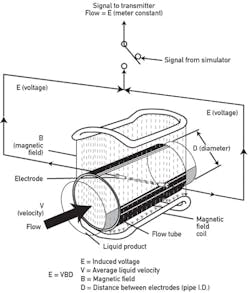Q: Magnetic flowmeters: Is there a term related to a magmeter with respect to measurement of zero flow? What maintenance is required for a magmeter?
William P. Reed
[email protected]
A: DC-pulsed, automatic zeroing, state-of-the art magmeters, (operating on Faraday's law), accurately detect the velocity of conductive fluids (0.5% of actual flow) and have a high turndown ratio, which in dual-range units can reach about 100:1.
Temperature variations and vibration can change the magnetic field. Coating, moisture, coil and electrode deterioration, corrosion or electronics can also cause drift and other errors. Magmeter performance is also subject to process property variations (changes in conductivity, air bubbles, slurries or in the potential in the flowing fluid, etc.) or to corrosion, grounding or cable shield deterioration. Therefore, maintenance is important.
My recommendation is to check (recalibrate) the electronics (transmitter and power supply) monthly by the use of a millivolt simulator (Figure 1). This checks and allows recalibration or rezeroing the electronics. In "smart flowmeters," the magnetic field strength and the electrode resistance can also be checked and compared to their original values automatically. Besides being quick and inexpensive, such verification can also be remotely triggered.
In old flowmeters, it is essential (often required by law) to yearly check the accuracy of the flow tube itself, the millivolts generated by the electrodes (E in Figure 1). This is done by checking the meter reading against that of another flowmeter (such as a clamp-on ultrasonic unit). For higher accuracy recalibration, see Dick Furness's advice below. Naturally, the resulting calibration accuracy will not be better than that of the reference meter. Consequently, if maximum accuracy is desired, the meter should be removed and after checking its condition and maintaining the electrodes, lining, etc., the meter should be recalibrated.
As to zero-flow condition, any signal under no-flow conditions is an error. It is common practice that, at the time of commissioning, the full and empty pipe zero-flow outputs are captured manually and stored, so that during operation these threshold values will trigger alarms. In smart, DC-pulsed automatic zeroing meters, the magnetic field strength is zero between pulses. Therefore, if the electrodes detect any voltage, it is automatically subtracted from the signal voltage as extraneous noise. Such features reduce maintenence cost and improve reliability.
In comparison to such state-of-the-art systems, old installations of conventional magmeters can have very high errors. Last year, as an expert witness, I reviewed a magmeter installation and found that the meter was under-reporting for decades by some 40%, due mostly to uncorrected zero-shift. This condition existed because only the electronics were recalibrated (Figure 1) and the flow tube itself was not removed, checked and recalibrated for decades.
So, while magmeters are good flowmeters, their yearly total maintenance and recalibration is essential.
Béla Lipták
[email protected]
A: I have had a lot of experience with magnetic flowmeters. In the last decade they have become very reliable, and in the lab we have run tests with velocities as low as a few millimeters per second and they record pretty well. As you approach zero flow, errors go first high and then fall to zero. Zero stability is an issue, as electrode ageing and coating do cause offsets as well as a measurement error. This is more noticeable in pipes that are oversized and old. Regular checks of the electronics and periodic verification using both dry calibrators as well as in situ flow assessment is essential.
Here in the U.K., magmeters are assessed rather haphazardly, and the use of insertion probes can lead to bias being introduced where previously there was very little. I also suggest an annual flow check should be the norm rather than the exception. I use two insertion probes in different planes, as well as multiple sets of ultrasonic probes clamped around the pipe, and all of this is done simultaneously. Both profile distortion and swirl can be evaluated, and from this, one can more correctly estimate the bias within the magnetic meter. This changes with time, so this is why periodic tests have to be made. My methods are now accepted by the U.K. Regulator as a bona fide means of verifying in situ. As a result of testing over many years, I know the ageing coefficients of most instruments. In a couple of decades significant errors always ensue.
Dick Furness
[email protected]
A: "Empty pipe detection" is provided in most magnetic flowmeters with cut-off to force the flow reading to zero at no flow to eliminate false counts in the totalizer. In some cases they serve to prevent the coil from overheating.
Magnetic flowmeters need calibration, but using smart meter verification, it is possible means to determine if calibration is really required or if it can wait a few months.
To learn more about empty pipe detection and smart meter verification, read more in this article: www.eddl.org/SiteCollectionDocuments/Articles/pg42-47-1-MAG3.pdf.
Jonas Berge
[email protected]
Q: Please can you explain the difference between "positional feed-forward" and "incremental feed-forward" in PID control? What are the pros and cons of these feed-forward algorithms. I understand that positional feed- forward is adding predefined value to the PID output. In what situations can we use with lead lag or without lead lag? What is the "incremental feed forward."
Kumar
[email protected]
A: Incremental feed-forward is essentially an impulse function that is applied to the manipulated variable only on a change in the load variable--it has no steady-state component. To minimize integrated error following a load change, the feed-forward signal must be applied in the steady state, that is, positionally. It can either be additive with a fixed gain, as typical when controlling liquid level, or multiplicative, where the gain of the multiplier is set by the output of the feedback controller, used when controlling temperature and composition.
Avoid incremental algorithms at all costs—they float and will cause all kinds of trouble and confusion.
Greg Shinskey
[email protected]
A: Google tells me from the list of hits that "positional feed-forward" is associated with robots and "incremental feed-forward" is associated with neural networks.
Where they are explained there is a forest of complex math that I am unable to penetrate. Never heard of them in process control. You should ask your vendor.
Bill Hawkins
[email protected]
Q: I see that in the proposed index of the fifth edition of your handbook, you plan to have a chapter on robots. Is it because that technology utilizes the principles that were developed by the process control industry? In other words, did they learn from us in the area of modeling?
Harry Crowney
[email protected]
A: The short answer is yes; the long answer would take volumes. What I plan to cover in the fifth edition of Volume 1 is only the measurement aspects, not the control algorithms or the manipulated variables. They will come in the second and third volumes. The sensors of this industry are interesting because they are drastically less expensive, lighter and smaller than in the traditional industries, while depending totally on wireless technology. You can see an example below: www.ted.com/talks/a_robot_that_flies_like_a_bird.html.
Béla Lipták
[email protected]






